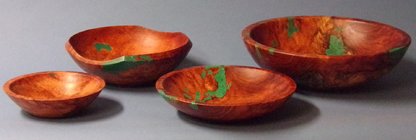Currently working on a 26" tall mesquite vase - beautiful wood and great pattern with the inclusions but seems like the worms had a field-day before I got there. My normal routine is to fill the worm-hole and problem areas with black G-Flex epoxy, cut it off, and then apply TimberMate water base, black of course, as needed in the finishing applications. This time I changed the process: due to the number of pits and holes, I spread on black G-Flex epoxy over the sealer knowing I would have to sand it off.
Jury is still out on final results but I can tell you sanding a big piece with troweled G-Flex makes for a bad day - I use a 5" dual-action pneumatic w 3/32-orbit - great for fine finish work, lousy for the task at hand. Instead of the recommended 220, I went with 150. After the first hour I knew what I'd be doing for the next 5 or 6.
Then I remembered some sagely advice: LIGHTEN UP WHEN USING SILICON CARBIDE. The stuff is so sharp that, if allowed to do the work, it cuts like crazy. In fact, the weight of the little sander was too much - I found that if I didn't allow it to compress the soft, worn-out, 1/2" pad, it removed both epoxy and sealer faster. I finished in less than 2-hrs.
Not sure if silicon carbide has an advantage on wood but, on finishes, my experience is "no comparison". While it's great for lacquer, you got no choice if you use catalyzed urethanes. The stuff is expensive compared to aluminum oxide - a good source is www.turningwood.com - Steve carries Kovax / Eagle product
Jury is still out on final results but I can tell you sanding a big piece with troweled G-Flex makes for a bad day - I use a 5" dual-action pneumatic w 3/32-orbit - great for fine finish work, lousy for the task at hand. Instead of the recommended 220, I went with 150. After the first hour I knew what I'd be doing for the next 5 or 6.
Then I remembered some sagely advice: LIGHTEN UP WHEN USING SILICON CARBIDE. The stuff is so sharp that, if allowed to do the work, it cuts like crazy. In fact, the weight of the little sander was too much - I found that if I didn't allow it to compress the soft, worn-out, 1/2" pad, it removed both epoxy and sealer faster. I finished in less than 2-hrs.
Not sure if silicon carbide has an advantage on wood but, on finishes, my experience is "no comparison". While it's great for lacquer, you got no choice if you use catalyzed urethanes. The stuff is expensive compared to aluminum oxide - a good source is www.turningwood.com - Steve carries Kovax / Eagle product


